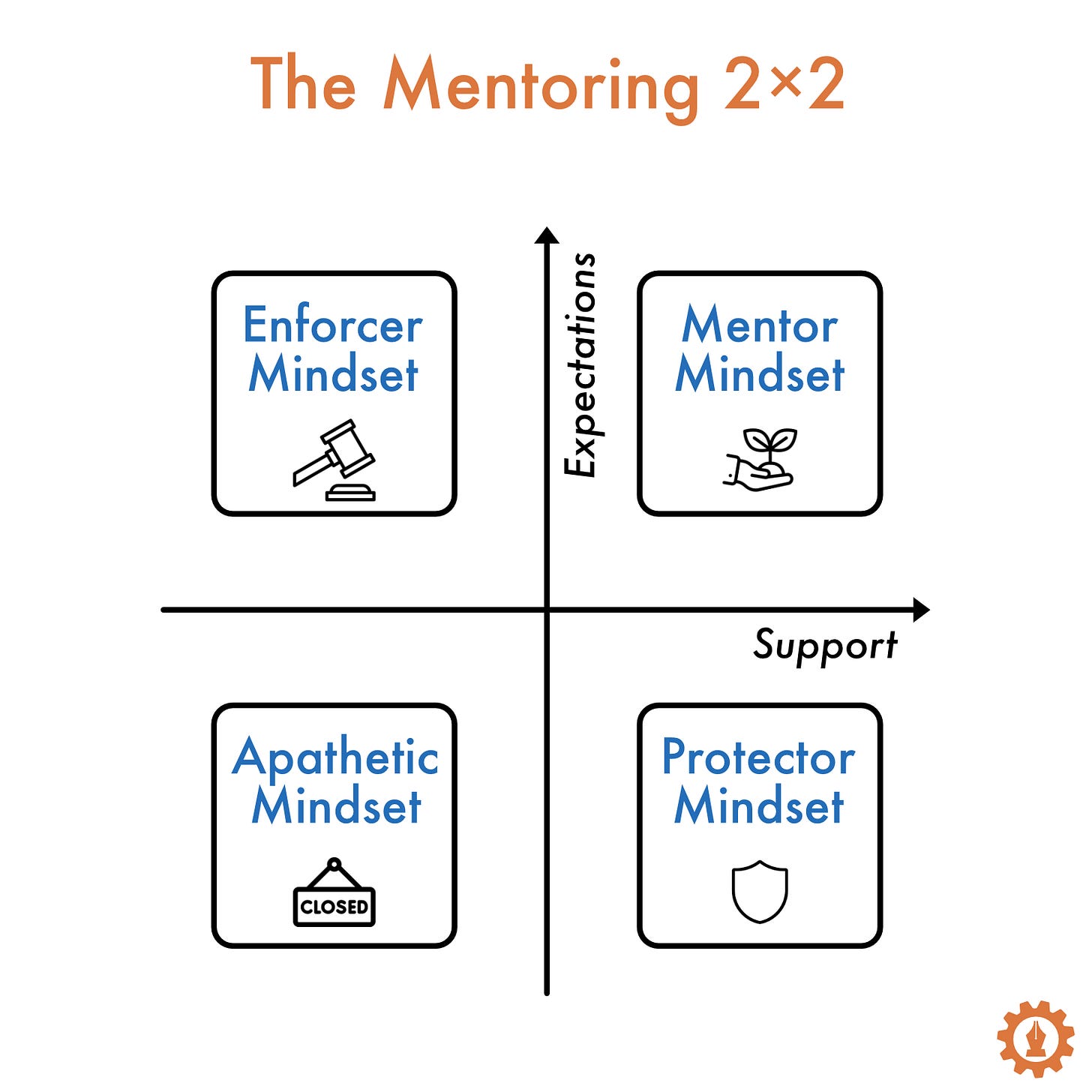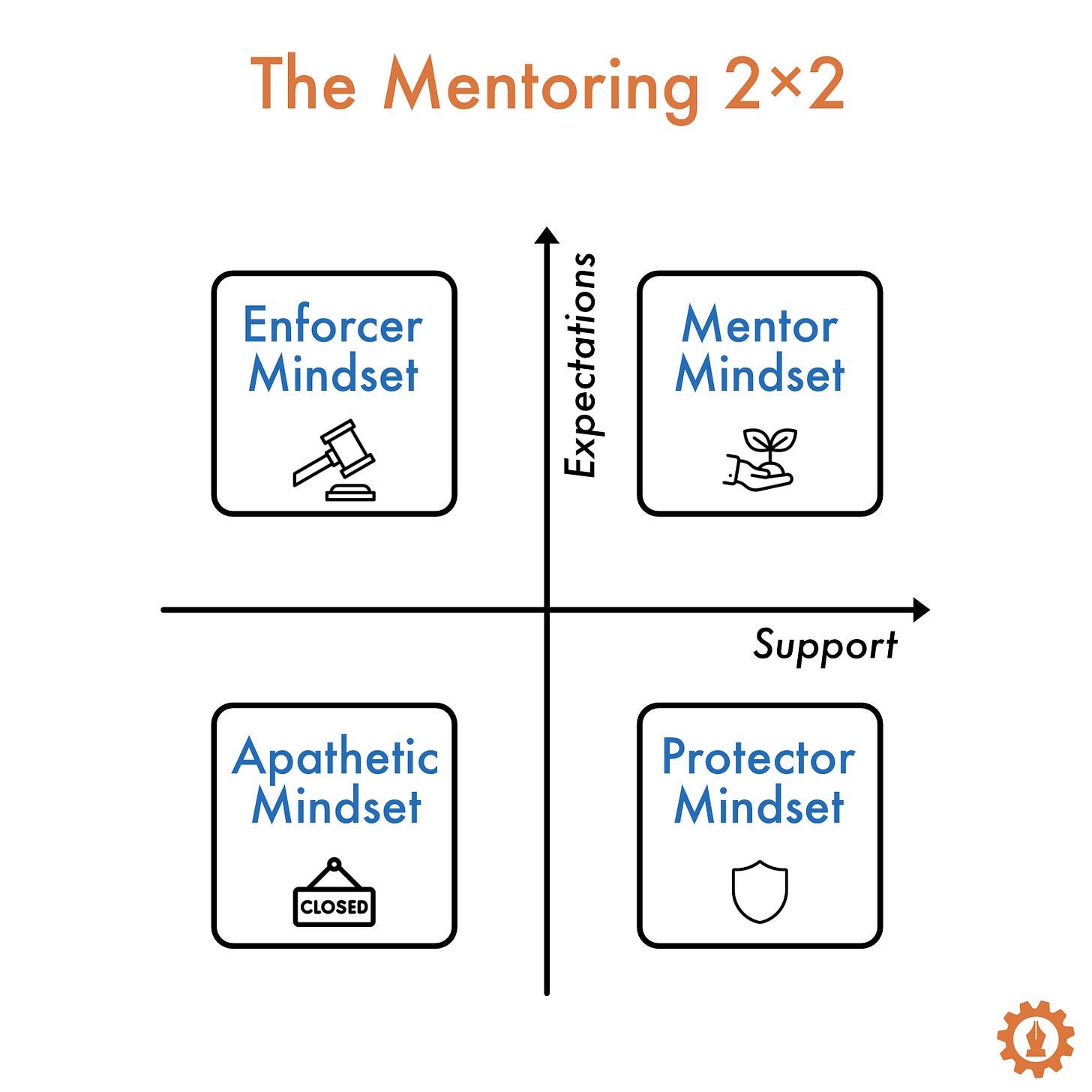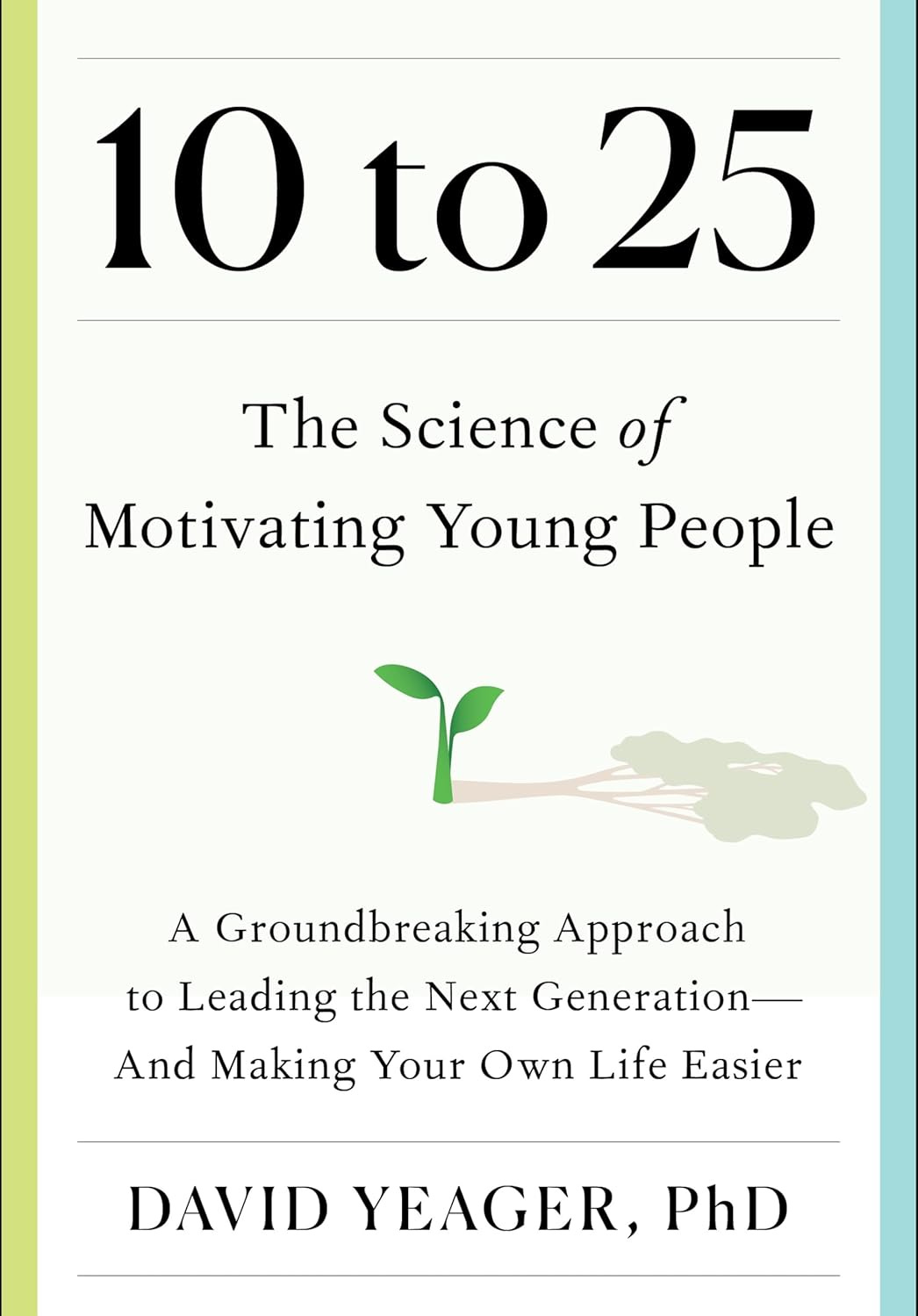High Standards, High Support
Why (and how) to build a Mentor Mindset
Thank you for being here. As always, these essays are free and publicly available without a paywall. If my writing is valuable to you, please share it with a friend or support me with a paid subscription.

When I look back at my life, the people at the center of the most formative experiences always demonstrated the combination of two things: high expectations and high support. But it wasn’t until I read David Yeager’s book 10 to 25: The Science of Motivating Young People earlier this year that I had the language to describe it in that way and articulate the failure modes that occur when either expectations or support are missing.
Today I want to share some brief reflections on David's book and introduce you to what David coins the Mentor Mindset. As we continue to grapple with the impact of generative AI on our work and life, the Mentor Mindset gives us a fruitful path forward. It may be ironic, but the most important thing you can do to respond to generative AI as a teacher—and we are all teachers in some context—is to become a better mentor. Today, I want to give you a peek into how the Mentor Mindset is shaping my own thinking, with the hopes that you may find ways that it will be helpful in yours.
The Mentoring 2×2
I’m a sucker for a good 2×2, so it's no surprise that the diagram David makes his case from resonates with me. These kinds of diagrams are helpful for many reasons.
First, they identify that the behaviors we want to emulate are often a combination of multiple factors working together. It's not just that we need more of one thing, but we need coherence between two or more forces.
But in addition to articulating the ingredients of a desired state, they do something even more important: indicating in concrete terms how deficiencies on one or both of the axes cause us to develop poor mentoring habits. From this point of diagnosis, the axes can help us develop a plan of attack to correct them.
The two axes of David's mentoring 2×2 are support and expectations. When we arrange these two axes orthogonally, they map out four quadrants. They are:
Mentor Mindset
Protector Mindset
Enforcer Mindset
Apathetic Mindset

Each quadrant describes an archetype for a kind of mentoring relationship. When you learn more about them, I'm willing to bet you'll be able to identify examples of each in your life, either presently or in your past.
The Mentoring 2×2 provides a lens for analysis and corrective action
1. The Apathetic Mindset
First up is the bottom left corner: low expectations, low support. We've all probably had these sorts of experiences—a teacher who didn't care and didn't ask anything of us, a boss who was checked out and uninvolved. David doesn't spend more than two sentences talking about these folks, and I won't either. If you're here and reading this, this isn't you. These are the kinds of toxic relationships where the relationship is actively harmful to your development.
2. The Enforcer Mindset
It gets more interesting when we move from this bottom left quadrant along either of the axes. If we add higher expectations without increasing support, we end up acting as an enforcer. Enforcers are able to articulate high standards for their teams, but they don't offer the support to help their team members achieve them. This quickly leads to frustration when team members inevitably fall short, not necessarily because of any wrongdoing on their part, but simply because they are not given the tools to succeed.
3. The Protector Mindset
On the other hand, if we move along the support axis without increasing expectations, we turn into protectors. Protectors care deeply for their team, but without giving the people under their care the clear direction and feedback they need to excel and grow. We often end up in this quadrant because of a well-intentioned desire to love our people well and offer grace when they make mistakes, but without providing high expectations, we aren't helping them hone their craft and, in the end, are doing them a disservice by stunting their professional growth.
4. The Mentor Mindset
So, given all of these failure modes, what happens when we couple high expectations with high support? This quadrant, which David labels the Mentor Mindset, is the place where sustainable growth happens.
A mentor knows how to set the bar for excellence clearly, but they don't stop there. They realize that to clear the bar, the people under their direction will need support. This doesn't mean that the Mentor does the work for their team member, but rather that they give the sorts of feedback, direction, coaching, and training that are necessary to equip their team members to excel.
Connections to the Mentor Mindset
As I am thinking about the application of the Mentor Mindset in my own context, I couldn't help about a few other frameworks that have been formative for me as an educator. The first is Kim Scott's concept of Radical Candor. The second is the practice of alternative grading.
At the beginning of the book, David spends some time comparing his Mentor Mindset 2×2 framework to other popular ones. In particular, he highlights the Radial Candor framework from Kim Scott, which offers guidance on giving good feedback (care personally and challenge directly). I've written previously about how Radical Candor has shaped my thinking. He also connects it to the work of Kurt Lewin, Diana Baumrind, and Rosalie Wax.
What is interesting in all of these examples is the way that Yeager's meta-level analysis pulls together the threads that each researcher found in their own particular sphere of study. What Yeager does is argue that these ideas are useful across domains, from teaching to parenting, providing language to help us analyze and build healthy formative habits in the various contexts where we operate as mentors.
The other thread that is relevant here is one that I've long been arguing is critical to effective education: alternative grading. At its root, alternative grading is about rethinking the traditional 0-100 grading that is the common standard almost everywhere grades are given. One way to understand the success of alternative grading is to see it as aligning assessment with the Mentor Mindset. To learn more, I highly recommend that you take a look at
and 's excellent Substack, .At the end of the day, the Mentor Mindset, like any framework, is only as good as the action that it helps catalyze. What makes Yeager's tool so useful is that it clearly articulates and helps us understand the ways that we, often with the best intentions, fall into practices that are ultimately not as helpful to the people under our care as they could be, whether they are our children, students, or junior colleagues.
This summer, perhaps it's worth pondering how you might upgrade your mentor mindset. In the remainder of the book, David goes on to share how to build these mentor-mindset practices by embracing transparency, questioning, stress, purpose, and belonging. If you’re looking to upgrade your mentoring practices at home, work, or school, I could hardly recommend a better book than 10 to 25. It is packed with insightful analysis and actionable advice to help you do just that.
Got a thought? Leave a comment below.
Reading Recommendations
writes a thoughtful piece reminding us that adapting to is the not the same as adopting.Perhaps the greatest challenge — and unique opportunity — posed by generative AI is that it forces us to rediscover what makes education a compassionate profession in a world in which machine intelligence threatens to make learning an entirely autonomous and transactional affair. By educating ourselves about this technology and guiding our students with wisdom, rather than fear, we can ensure that higher education continues to cultivate the uniquely human capacities for creativity, critical thinking, and ethical judgment that no algorithm can ever replicate.
My buddy
is a riled up (again). John’s at his best when he’s got a fire lit under him.In theory, optimization is fine, and there’s many ways we could all benefit from efficiency, but there is an ideology at the center of this - one well illustrated by the mindset of Matthew Barnett that seeks to remove all friction.
This is not the promise of optimization, but of liberation.
But liberation from what, exactly?
Honestly, it seems like they intend to liberate us from the experience of living and replacing it with lives of bottomless consumption.
The Book Nook
Perhaps unsurprisingly, the book recommendation for this week is David’s book. It’s very digestible, filled with relatable anecdotes, and formatted in a way that makes it easy to go back and refresh on as you work to iteratively incorporate his ideas into your practices.
The Professor Is In
Hard to believe we are already past the halfway point of my students’ summer research experience. Proud of the work that they are doing and excited to see the way that they’re accelerating on their projects and taking ownership.
Leisure Line
Imagine my delight when rolling off the LIRR into Penn Station at 12:57 am on the way to my hotel, I discovered that Raising Cane’s was still open. After a late departure out of LAX and a five-hour flight, those chicken fingers and Texas toast never tasted so good.
Still Life


Crossed one off the bucket list with a quick e-bike ride in Central Park yesterday morning. The picture doesn’t do it justice, but even at 9 am, it was already almost 95˚ with 70% humidity. Yuck.










This is so useful! Thank you for sharing
I love your illustration of the Mentor Mindset! I too have found the book extremely helpful.